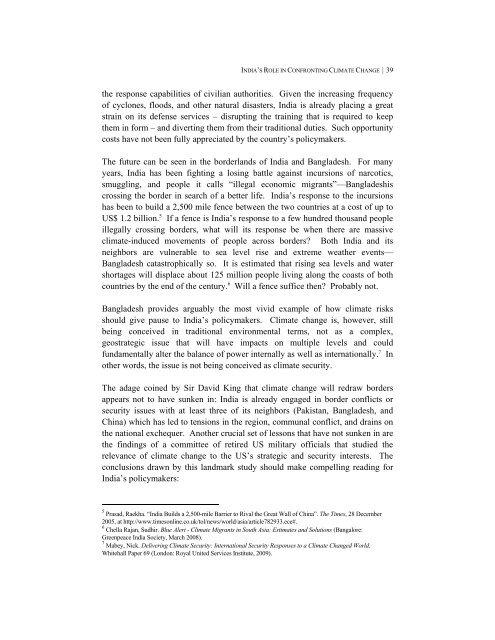Indian Climate Policy - Global Commons Institute
Indian Climate Policy - Global Commons Institute
Indian Climate Policy - Global Commons Institute
You also want an ePaper? Increase the reach of your titles
YUMPU automatically turns print PDFs into web optimized ePapers that Google loves.
INDIA’S ROLE IN CONFRONTING CLIMATE CHANGE | 39<br />
the response capabilities of civilian authorities. Given the increasing frequency<br />
of cyclones, floods, and other natural disasters, India is already placing a great<br />
strain on its defense services – disrupting the training that is required to keep<br />
them in form – and diverting them from their traditional duties. Such opportunity<br />
costs have not been fully appreciated by the country’s policymakers.<br />
The future can be seen in the borderlands of India and Bangladesh. For many<br />
years, India has been fighting a losing battle against incursions of narcotics,<br />
smuggling, and people it calls “illegal economic migrants”—Bangladeshis<br />
crossing the border in search of a better life. India’s response to the incursions<br />
has been to build a 2,500 mile fence between the two countries at a cost of up to<br />
US$ 1.2 billion. 5 If a fence is India’s response to a few hundred thousand people<br />
illegally crossing borders, what will its response be when there are massive<br />
climate-induced movements of people across borders? Both India and its<br />
neighbors are vulnerable to sea level rise and extreme weather events—<br />
Bangladesh catastrophically so. It is estimated that rising sea levels and water<br />
shortages will displace about 125 million people living along the coasts of both<br />
countries by the end of the century. 6 Will a fence suffice then? Probably not.<br />
Bangladesh provides arguably the most vivid example of how climate risks<br />
should give pause to India’s policymakers. <strong>Climate</strong> change is, however, still<br />
being conceived in traditional environmental terms, not as a complex,<br />
geostrategic issue that will have impacts on multiple levels and could<br />
fundamentally alter the balance of power internally as well as internationally. 7 In<br />
other words, the issue is not being conceived as climate security.<br />
The adage coined by Sir David King that climate change will redraw borders<br />
appears not to have sunken in: India is already engaged in border conflicts or<br />
security issues with at least three of its neighbors (Pakistan, Bangladesh, and<br />
China) which has led to tensions in the region, communal conflict, and drains on<br />
the national exchequer. Another crucial set of lessons that have not sunken in are<br />
the findings of a committee of retired US military officials that studied the<br />
relevance of climate change to the US’s strategic and security interests. The<br />
conclusions drawn by this landmark study should make compelling reading for<br />
India’s policymakers:<br />
5 Prasad, Raekha. “India Builds a 2,500-mile Barrier to Rival the Great Wall of China”. The Times, 28 December<br />
2005, at http://www.timesonline.co.uk/tol/news/world/asia/article782933.ece#.<br />
6 Chella Rajan, Sudhir. Blue Alert - <strong>Climate</strong> Migrants in South Asia: Estimates and Solutions (Bangalore:<br />
Greenpeace India Society, March 2008).<br />
7 Mabey, Nick. Delivering <strong>Climate</strong> Security: International Security Responses to a <strong>Climate</strong> Changed World.<br />
Whitehall Paper 69 (London: Royal United Services <strong>Institute</strong>, 2009).
















